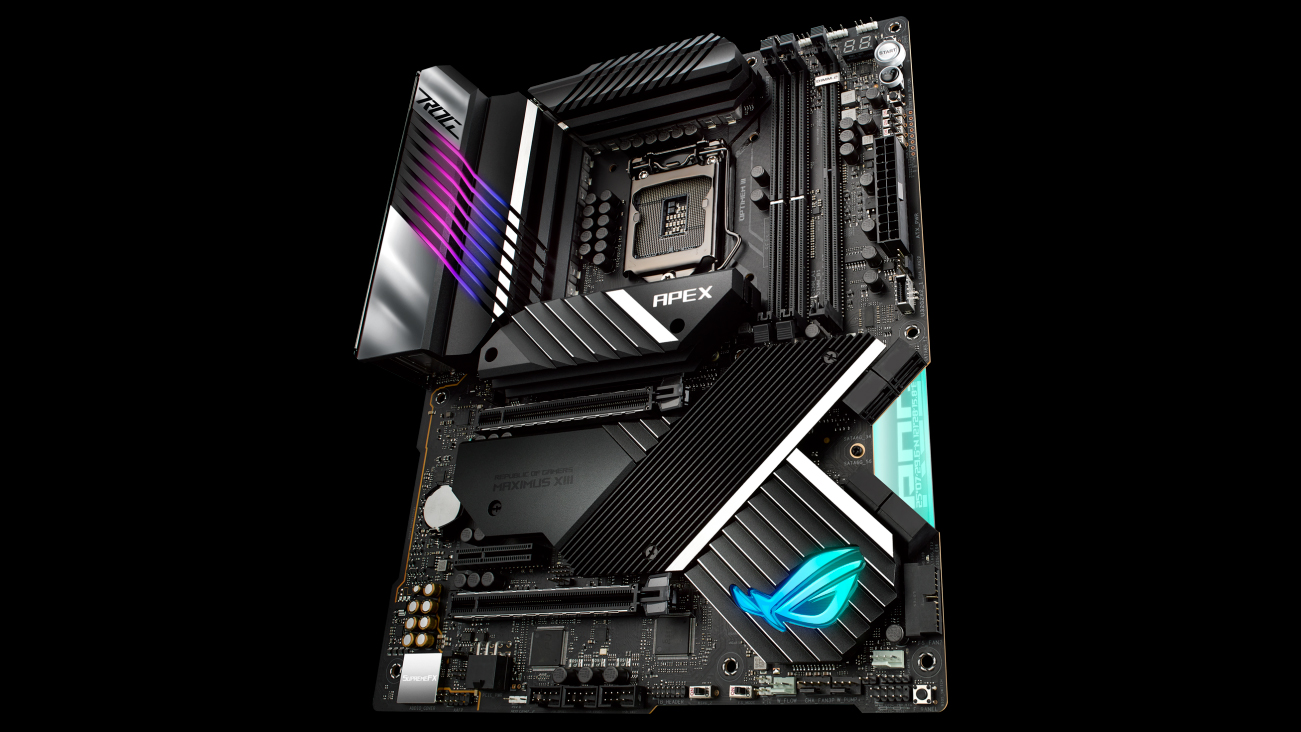Asus has listed the ROG Maximus XIII Apex on its website, implying that the successor to the ROG Maximus XII Apex may be closer than we think. The new iteration to the Apex series has been engineered to tame Intel’s 11th Generation Rocket Lake processors.
Built around the new Z590 chipset and existing LGA1200 socket, the ROG Maximus XIII Apex comes equipped with an 18-phase power delivery subsystem. Each power stage, which can manage up to 90 amps, is accompanied by a MicroFine Alloy choke that can do 45 amps. Asus revamped the power design on the ROG Maximus XIII Apex completely by getting rid of the phase doublers. The motherboard also employs 10K Japanese black metallic capacitors that can take a beating. The VRM area is properly cooled with thick, aluminum passive heatsinks. The ROG Maximus XIII Apex feeds Rocket Lake chips through a pair of 8-pin EPS power connectors.
The overclocking toolkit on the ROG Maximus XIII Apex includes a double-digit debug LED, voltage read points, and a plethora of buttons and switches to aid in overclocking. There are also three condensation sensors that are placed strategically across the motherboard to notify you when condensation occurs around the processor, memory or PCIe slot. In total, the ROG Maximus XIII Apex has five temperature sensors, five 4-pin fan headers, two full-speed fan headers, and an assortment of headers for watercooling setups.
Like previous Apex motherboards, the ROG Maximus XIII Apex only provides two DDR4 memory slots. While memory capacity is limited to 64GB, the motherboard supports memory frequencies above DDR4-5000 with ease. The ROG Maximus XIII Apex sports Asus’ OptiMem III technology, featuring an optimized memory tracing layout to improve memory overclocking.
Image 1 of 3
Image 2 of 3
Image 3 of 3
The ROG Maximus XIII Apex offers numerous options for storage. It provides eight SATA III ports and up to four M.2 slots. The M.2 slots on the motherboard are PCIe 4.0 ready and come armed with an aluminium heatsink and embedded backplates to provide passive cooling. The other two M.2 slots reside on Asus’ ROG DIMM.2 module that connects to the motherboard through a DDR4-type interface beside the memory slots. The DIMM.2 module accommodates M.2 drives with lengths up to 110mm.
The expansion slots on the ROG Maximus XIII Apex consist of two PCIe x16 slots and one PCIe x8 slot. Wired and wireless networking come in the shape of a 2.5 Gigabit Ethernet port and Wi-Fi 6E connectivity with support for up to 6GHz bands. The audio system on the ROG Maximus XIII Apex uses Realtek’s ALC4080 audio codec complemented with a Savitech SV3H712 amplifier and high-end Nichicon audio capacitors.
In regards to USB ports, the ROG Maximus XIII Apex has four USB 3.2 Gen 1 ports, five USB 3.2 Gen 2 ports and one USB 3.2 Gen 2×2 Type-C port at the rear panel. There’s an additional USB 3.2 Gen 2×2 header on the motherboard. The ROG Maximus XIII Apex doesn’t supply any display outputs so it’s mandatory to pair it with a discrete graphics card.
ROG motherboards have a very rich software suite. On this iteration, Asus has directly implemented MemTest86 into the ROG Maximus XIII Apex’s firmware so overclockers can test memory stability without any hassles. Additionally, a one-year AIDA64 Extreme subscription is also included.
The pricing for the ROG Maximus XIII Apex is currently unknown. The previous Z490 version retailed for $356.99, so we can expect the Z590 followup to be price around that range if not a little bit higher.
